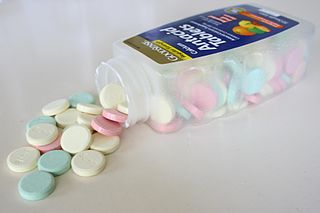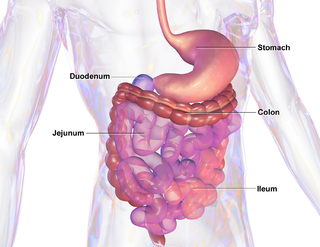Related Research Articles

An antacid is a substance that neutralizes stomach acidity and is used to relieve heartburn, indigestion, or an upset stomach. Some antacids have been used in the treatment of constipation and diarrhea. Marketed antacids contain salts of aluminum, calcium, magnesium, or sodium. Some preparations contain a combination of two salts, such as magnesium carbonate and aluminum hydroxide.
Heartburn, also known as pyrosis, cardialgia or acid indigestion, is a burning sensation in the central chest or upper central abdomen. Heartburn is usually due to regurgitation of gastric acid into the esophagus. It is the major symptom of gastroesophageal reflux disease (GERD).

Lidocaine, also known as lignocaine and sold under the brand name Xylocaine among others, is a local anesthetic of the amino amide type. It is also used to treat ventricular tachycardia. When used for local anaesthesia or in nerve blocks, lidocaine typically begins working within several minutes and lasts for half an hour to three hours. Lidocaine mixtures may also be applied directly to the skin or mucous membranes to numb the area. It is often used mixed with a small amount of adrenaline (epinephrine) to prolong its local effects and to decrease bleeding.
Functional abdominal pain syndrome (FAPS), chronic functional abdominal pain (CFAP), or centrally mediated abdominal pain syndrome (CMAP) is a pain syndrome of the abdomen, that has been present for at least six months, is not well connected to gastrointestinal function, and is accompanied by some loss of everyday activities. The discomfort is persistent, near-constant, or regularly reoccurring. The absence of symptom association with food intake or defecation distinguishes functional abdominal pain syndrome from other functional gastrointestinal illnesses, such as irritable bowel syndrome (IBS) and functional dyspepsia.

Abdominal pain, also known as a stomach ache, is a symptom associated with both non-serious and serious medical issues. Since the abdomen contains most of the body's vital organs, it can be an indicator of a wide variety of diseases. Given that, approaching the examination of a person and planning of a differential diagnosis is extremely important.
Functional gastrointestinal disorders (FGID), also known as disorders of gut–brain interaction, include a number of separate idiopathic disorders which affect different parts of the gastrointestinal tract and involve visceral hypersensitivity and motility disturbances.

Gastritis is inflammation of the lining of the stomach. It may occur as a short episode or may be of a long duration. There may be no symptoms but, when symptoms are present, the most common is upper abdominal pain. Other possible symptoms include nausea and vomiting, bloating, loss of appetite and heartburn. Complications may include stomach bleeding, stomach ulcers, and stomach tumors. When due to autoimmune problems, low red blood cells due to not enough vitamin B12 may occur, a condition known as pernicious anemia.
Simeticone (INN), also known as simethicone (USAN), is an anti-foaming agent used to reduce bloating, discomfort or pain caused by excessive gas.
Indigestion, also known as dyspepsia or upset stomach, is a condition of impaired digestion. Symptoms may include upper abdominal fullness, heartburn, nausea, belching, or upper abdominal pain. People may also experience feeling full earlier than expected when eating. Indigestion is relatively common, affecting 20% of people at some point during their life, and is frequently caused by gastroesophageal reflux disease (GERD) or gastritis.

Gastrointestinal perforation, also known as gastrointestinal rupture, is a hole in the wall of the gastrointestinal tract. The gastrointestinal tract is composed of hollow digestive organs leading from the mouth to the anus. Symptoms of gastrointestinal perforation commonly include severe abdominal pain, nausea, and vomiting. Complications include a painful inflammation of the inner lining of the abdominal wall and sepsis.
Maalox was a brand of antacid owned by Sanofi. Their main product is a flavored liquid containing a suspension of aluminum hydroxide and magnesium hydroxide, which act to neutralize or reduce stomach acid, for the purpose of relieving the symptoms of indigestion, heartburn, gastroesophageal reflux disease, and also stomach or duodenal ulcers. It also contains simethicone, an anti-foaming agent which helps eliminate bloating from gas. In large doses, the medicine can act as a laxative. The trademark is owned by Novartis International AG, and was first produced commercially in 1949.
Postcholecystectomy syndrome (PCS) describes the presence of abdominal symptoms after a cholecystectomy.

Mucositis is the painful inflammation and ulceration of the mucous membranes lining the digestive tract, usually as an adverse effect of chemotherapy and radiotherapy treatment for cancer. Mucositis can occur anywhere along the gastrointestinal (GI) tract, but oral mucositis refers to the particular inflammation and ulceration that occurs in the mouth. Oral mucositis is a common and often debilitating complication of cancer treatment.
The Rome process and Rome criteria are an international effort to create scientific data to help in the diagnosis and treatment of functional gastrointestinal disorders, such as irritable bowel syndrome, functional dyspepsia and rumination syndrome. The Rome diagnostic criteria are set forth by Rome Foundation, a not for profit 501(c)(3) organization based in Raleigh, North Carolina, United States.
In medicine, pink lady is a term used for a combination of medications used to treat gastroesophageal reflux or gastritis. It usually consists of an antacid and the anaesthetic lidocaine. Some variants contain an anticholinergic. The name of the preparation comes from its colour – pink.

Lubiprostone, sold under the brand name Amitiza among others, is a medication used in the management of chronic idiopathic constipation, predominantly irritable bowel syndrome-associated constipation in women and opioid-induced constipation. The drug is owned by Mallinckrodt and is marketed by Takeda Pharmaceutical Company.
Donnatal is a combination medication that provides natural belladonna alkaloids in a specific fixed ratio combined with phenobarbital to provide peripheral anticholinergic/antispasmodic action and mild sedation. Donnatal is manufactured for Concordia Pharmaceuticals by IriSys, LLC. It is available as tablets and 5 mL elixir. Active ingredients are listed as: phenobarbital (16.2 mg), hyoscyamine sulfate (0.1037 mg), atropine sulfate (0.0194 mg), and scopolamine hydrobromide (0.0065 mg). The latter two ingredients are found in plants of the family Solanaceae, such as belladonna.
Dental anesthesia is the application of anesthesia to dentistry. It includes local anesthetics, sedation, and general anesthesia.

Itopride (INN; brand name Ganaton) is a prokinetic benzamide derivative. These drugs inhibit dopamine and acetylcholine esterase enzyme and have a gastrokinetic effect. Itopride is indicated for the treatment of functional dyspepsia and other gastrointestinal conditions. It is a combined D2 receptor antagonist and acetylcholinesterase inhibitor.

Nausea is a diffuse sensation of unease and discomfort, sometimes perceived as an urge to vomit. While not painful, it can be a debilitating symptom if prolonged and has been described as placing discomfort on the chest, abdomen, or back of the throat.
References
- 1 2 3 4 5 6 7 Berman DA, Porter RS, Graber M (October 2003). "The GI Cocktail is no more effective than plain liquid antacid: a randomized, double blind clinical trial". The Journal of Emergency Medicine. 25 (3): 239–244. doi:10.1016/S0736-4679(03)00196-3. PMID 14585449.
- 1 2 3 Warren J, Cooper B, Jermakoff A, Knott JC (September 2020). "Antacid Monotherapy Is More Effective in Relieving Epigastric Pain Than in Combination With Lidocaine: A Randomized Double-blind Clinical Trial". Academic Emergency Medicine. 27 (9): 905–909. doi:10.1111/acem.14069. hdl: 11343/276044 . PMID 32602148. S2CID 220269999.
- 1 2 3 Hamilton R (15 October 2010). Tarascon Pocket Pharmacopoeia 2010 Classic Shirt-Pocket Edition. Jones & Bartlett Learning. ISBN 978-0-7637-7439-4.
- 1 2 Welling LR, Watson WA (July 1990). "The emergency department treatment of dyspepsia with antacids and oral lidocaine". Annals of Emergency Medicine. 19 (7): 785–788. doi:10.1016/s0196-0644(05)81704-4. PMID 2202240.
- 1 2 Talley NJ, Silverstein MD, Agréus L, Nyrén O, Sonnenberg A, Holtmann G (March 1998). "AGA technical review: evaluation of dyspepsia. American Gastroenterological Association". Gastroenterology. 114 (3): 582–595. doi:10.1016/S0016-5085(98)70542-6. PMID 9496950.
- 1 2 Fisher RS, Parkman HP (November 1998). "Management of nonulcer dyspepsia". The New England Journal of Medicine. 339 (19): 1376–1381. doi:10.1056/NEJM199811053391907. PMID 9801400.
- 1 2 Vilke GM, Jin A, Davis DP, Chan TC (July 2004). "Prospective randomized study of viscous lidocaine versus benzocaine in a GI cocktail for dyspepsia". The Journal of Emergency Medicine. 27 (1): 7–9. doi:10.1016/j.jemermed.2003.12.026. PMID 15219296.
- ↑ "CFR – Code of Federal Regulations Title 21". www.accessdata.fda.gov. Retrieved 22 March 2022.
- ↑ Lieberman JA (2004). "Managing anticholinergic side effects". Primary Care Companion to the Journal of Clinical Psychiatry. 6 (Suppl 2): 20–23. PMC 487008 . PMID 16001097.